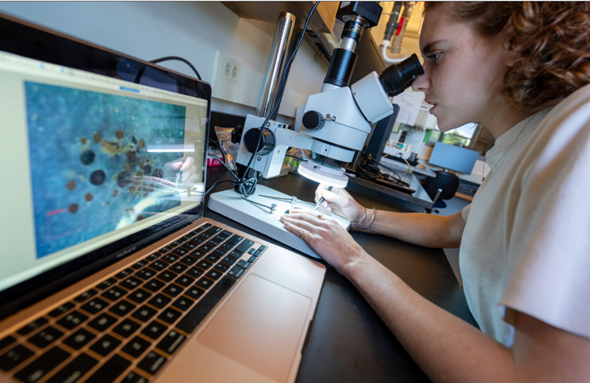
Ancient Tundra Ecosystem Unveiled Under Greenland's Ice Sheet
A recently published study has uncovered evidence of an ancient tundra ecosystem beneath Greenland's thickest ice. The analysis of forgotten sediment samples revealed the presence of fungi, willow wood, insect remains, and an Arctic poppy seed.
Researchers found that the thickest part of the Greenland Ice Sheet had completely melted sometime in the past 1.1 million years. The study, published in the Proceedings of the National Academy of Sciences, included fossilized bits of moss, wood fragments, insect and fungi remnants, and a seed from an Arctic poppy.
These samples, collected decades ago from beneath 2 miles of ice, indicate that a rocky tundra landscape once existed in central Greenland. During this period, the global average temperature was similar to the levels projected for the end of this century. The findings highlight the sensitivity of the Greenland Ice Sheet to even modest warming, stated Paul Bierman, a geologist at the University of Vermont and lead author of the study.
"There have been doubts about the sensitivity of the ice sheet, but this evidence shows its vulnerability," Bierman said. "The presence of these fossils disproves the idea that only the ice sheet's edges are at risk."
The fossils were found in the bottom of a two-mile ice core drilled in 1993 at GISP2, near the summit of the ice sheet. If the entire ice sheet were to melt, it would raise sea levels by approximately 24 feet (7.4 meters). While the fossils are fascinating, Bierman warned that they raise concerns about the current warming trends driven by fossil fuel combustion.
He explained that if the ice covering the center of Greenland melted, much of the surrounding ice likely melted as well, allowing time for soil to form and an ecosystem to develop.
"We now have concrete evidence that plants and insects once thrived in Greenland," Bierman said. "This evidence is irrefutable and doesn't rely on models or calculations."
In 2016, a study revealed cosmic ray exposure in Greenland rocks now covered by two miles of ice, suggesting a time within the last million years when temperatures were slightly higher than today. Richard Alley, a geoscientist at Pennsylvania State University, noted that the new study confirms and extends this information, indicating the presence of a tundra ecosystem during a relatively warm period.
Co-author Halley Mastro, a paleoclimate researcher at the University of Vermont, meticulously studied the biological remnants under a microscope. The findings, though not entirely unexpected, were consistent with previous studies that found elevated levels of organic compounds in ice layers above the sediments, suggesting a ground-level origin.
Mastro and Bierman believe the organic sediments date back to an interglacial period about 400,000 years ago, when carbon dioxide levels were lower but summertime temperatures were higher. Similar samples from thinner ice at Camp Century in northwest Greenland have allowed for more precise dating.
Recent research has shown that scientists have underestimated Greenland's rate of ice loss by about 20 percent. New threats, including large areas of accumulating slush and an increase in extreme rainfall, have been identified. Additionally, micro-cracks in the ice sheet could accelerate melting.
Greenland's melting ice is not only raising sea levels but also contributing to extreme weather in Europe and disrupting the Atlantic Meridional Overturning Current (AMOC), which could have severe climate consequences, especially for northern Europe's agriculture.
Bierman highlighted the alarming feedback loops as global warming melts the ice sheet edges and from the top. Darker rocks and ground exposed by melting ice absorb more heat, accelerating the melting process. As the ice sheet's elevation decreases, warmer atmospheric layers further hasten melting.
"If the summit's snow accumulation stops, it could signal the end of the ice sheet," Bierman warned. "This is why we should be genuinely concerned."
In 2023, scientists confirmed that the 2000-2010 decade was the warmest in at least 1,000 years on the ice sheet's summit. Joseph MacGregor, a research scientist with NASA Goddard Space Flight Center, noted that the new study strengthens the argument that Greenland's landscape could drastically change if current warming trends continue.
"The perception that the Greenland ice is more stable than parts of the Antarctic Ice Sheet may still hold, but this study shows Greenland's sensitivity to warming," MacGregor said.
Bierman emphasized that while the findings should not surprise those following climate science, the speed at which these changes are occurring is startling.